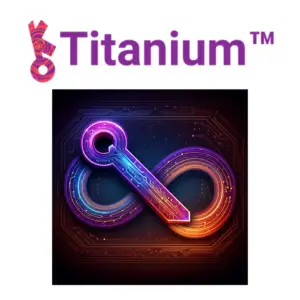
QuSmart.AI™ Titanium™ Engine: A New Era in Perfect Secrecy Whitepaper
QuSmart.AI™ Titanium™ Engine: A New Era in Perfect Secrecy Whitepaper Date of Test: 12-12-2023, 1:27 p.m. est. Research Testers: Greg

Founding Scientist, Chief Scientific Officer

According to a Nature.com scholarly article titled Mathematical discoveries from program search with large language models, a new challenge is emerging: the convergence of Large Language Models (LLMs) like GPT-4 and Genetic Algorithms (GAs). This fusion is creating powerful tools, but it also raises critical questions about the security of widely used encryption algorithms such as Advanced Encryption Standard (AES) with a 256-bit key (AES-256).
LLMs have demonstrated remarkable abilities in understanding and generating human-like text, solving complex problems, and even coding. Meanwhile, GAs, inspired by the process of natural selection, excel in optimization problems, adapting over generations to find the best solution. The integration of these two technologies offers unparalleled potential for problem-solving. As these advanced tools potentially threaten the security of algorithms like AES-256, the concept of perfect secrecy emerges as a crucial goal in cryptographic evolution.
Implications for AES-256
AES-256, a cornerstone in modern cryptography, is considered highly secure and is widely used for encrypting sensitive data. However, the combined capabilities of LLMs and GAs could, theoretically, challenge this security. GAs could be used to evolve increasingly effective strategies for cryptographic analysis, while LLMs could refine these strategies and even suggest novel approaches.
While the theoretical risk to AES-256 is noteworthy, it’s important to recognize the practical limitations exist today but may not exist tomorrow. The rapid advancement of LLM-GA convergence could change this landscape, necessitating a reevaluation of encryption strategies.
The potential risks posed by the convergence of LLMs and GAs underscore the need for proactive measures in the field of cryptography. The government and business leaders must stay ahead of these advancements, and partner outside of the traditional groups of mathematicians against mathematicians.
The fusion of LLMs and GAs is a testament to human ingenuity in the realm of artificial intelligence. While it opens exciting possibilities, it also reminds us of the need to continually adapt our security measures and go beyond the interim Post Quantum Cryptography standards.
Perfect Secrecy: The Ideal Goal
In response to these emerging threats, the cryptographic community is increasingly focusing on the concept of perfect secrecy. As defined by Claude Shannon, perfect secrecy means that the ciphertext (encrypted text) gives no additional information about the plaintext (original message) without the key. This concept is the gold standard in encryption, ensuring that a message remains completely secure regardless of computational advancements.
As we witness the burgeoning capabilities of LLM and GA convergence, the cryptographic community must pivot toward achieving perfect secrecy. This goal is not just a theoretical ideal but a necessary response to ensure the integrity and security of our digital communications in the face of rapidly evolving AI technologies.
The road to perfect secrecy in a world dominated by advanced AI technologies like LLM-GA convergence is fraught with challenges. It requires technological advancements and new frameworks for key management and encryption. The future of cryptography will involve a dynamic interplay between developing advanced AI tools like the QuSmart™ Solutions with the Titanium™ Engine: A Quantum-Proof, KEYLESS System that provides perfect secrecy for data in motion and at rest is the next-gen solution.

QuSmart.AI™ Titanium™ Engine: A New Era in Perfect Secrecy Whitepaper Date of Test: 12-12-2023, 1:27 p.m. est. Research Testers: Greg

The whitepaper presents a comprehensive comparison between the patent-pending technology from QuSmart.AI and AES256. Our solution can easily be used in IOT devices and hardware.

As we witness the burgeoning capabilities of LLM and GA convergence, the cryptographic community must pivot toward achieving perfect secrecy. This goal is not just a theoretical ideal but a necessary response to ensure the integrity and security of our digital communications in the face of rapidly evolving AI technologies.